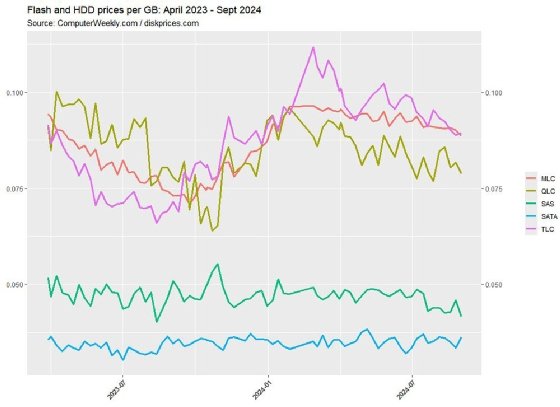Flash drive prices fell steadily over the first three quarters of 2024 to an average of $0.085 per gigabyte (GB) in September 2024. That’s a drop of just over 10% since April and is the result of prices slackening after highs earlier in the year.
Flash prices spiked significantly in late 2023 and the early months of this year as manufacturers throttled back production in an effort to raise prices and achieve profitability. Solid-state drive (SSD) prices per gigabyte shot upwards to achieve an average of $0.095/GB by April 2024, which was a rise of 26.67% since autumn 2023.
At that time, it was believed SSD prices would hit very significant highs going further into 2024. This seems not to have come to pass because as production increased, customer demand did not follow and prices decreased.
Meanwhile, average spinning disk (SAS and SATA) hard drive prices have held steady at $0.039 per gigabyte. That figure was $0.041/GB in early April. That average results from a current price of $0.041/GB for SAS and $0.036/GB for SATA.
Looking at flash drive sub-types, triple-level cell (TLC) flash achieved the highest price per gigabyte in February, at $0.11/GB. At the same time, multi-level cell (MLC) flash, the most numerous type sampled, was at $0.096/GB and high-capacity quad-level cell (QLC) was at $0.088/GB.
Those figures are the result of exclusive analysis by Computer Weekly that gathers drive prices weekly from Amazon.com and which are aggregated by Diskprices.com (see graph). Since March 2023, more than 45,000 drive prices and specifications have been gathered, with averages calculated every week for TLC, QLC and MLC/unspecified flash drives, as well as SAS and SATA spinning disk.

The number crunching uses Diskprices.com’s aggregation of new drive prices taken from Amazon.com, with an average of more than 500 disk prices and specifications processed each week. Data is then filtered by flash and spinning disk type and average price per gigabyte calculated for each week.
The data gathered covers drives that range in capacity from less than 1TB (terabyte) up to 24TB for hard disk drives (HDDs) and up to 12TB for SSDs, with an average of 3.9TB per drive offered for sale.
While the analysis is based on Amazon.com prices, and these are aimed at consumers and SMEs, the volume of data gathered does show trends in drive pricing. In the absence of price data from enterprise drive and storage array makers, it serves as a proxy for drive prices.
Price per gigabyte is a major consideration for customers, but total cost of ownership over a drive’s lifecycle is also important, with purchase cost, energy usage and maintenance costs key among them.
The jury is out on whether flash drives are always more efficient in energy terms than spinning disk. Calculations by Computer Weekly seem to indicate it really depends on the make of drive chosen. Flash can win out, however, when it comes to density of storage as capacities increase.
SSD costs more per drive to buy than spinning disk, but maintenance costs are often lower. Cloud storage provider Backblaze – which publishes reliability figures for the hundreds of thousands of drives in its estate – found its SSD annual failure rate (AFR) to be 0.9% in mid-2023. There’s been no SSD AFR stats for SSDs from Backblaze this year, but for HDDs in August 2024 the figure was 1.71%.





